Expression of neural cell adhesion molecule and polysialic acid in human bone marrow-derived mesenchymal stromal cells
- PMID: 27528376
- PMCID: PMC4986182
- DOI: 10.1186/s13287-016-0373-5
Expression of neural cell adhesion molecule and polysialic acid in human bone marrow-derived mesenchymal stromal cells
Abstract
Background: In order to develop novel clinical applications and to gain insights into possible therapeutic mechanisms, detailed molecular characterization of human bone marrow-derived mesenchymal stromal cells (hBM-MSCs) is needed. Neural cell adhesion molecule (NCAM, CD56) is a transmembrane glycoprotein modulating cell-cell and cell-matrix interactions. An additional post-translational modification of NCAM is the α2,8-linked polysialic acid (polySia). Because of its background, NCAM is often considered a marker of neural lineage commitment. Generally, hBM-MSCs are considered to be devoid of NCAM expression, but more rigorous characterization is needed.
Methods: We have studied NCAM and polySia expression in five hBM-MSC lines at mRNA and protein levels. Cell surface localization was confirmed by immunofluorescence staining and expression frequency in the donor-specific lines by flow cytometry. For the detection of poorly immunogenic polySia, a fluorochrome-tagged catalytically defective enzyme was employed.
Results: All five known NCAM isoforms are expressed in these cells at mRNA level and the three main isoforms are present at protein level. Both polysialyltransferases, generally responsible for NCAM polysialylation, are expressed at mRNA level, but only very few cells express polySia at the cell surface.
Conclusions: Our results underline the need for a careful control of methods and conditions in the characterization of MSCs. This study shows that, against the generally held view, clinical-grade hBM-MSCs do express NCAM. In contrast, although both polysialyltransferase genes are transcribed in these cells, very few express polySia at the cell surface. NCAM and polySia represent new candidate molecules for influencing MSC interactions.
Keywords: Bone marrow; Clinical grade; Mesenchymal stromal cell; Neural cell adhesion molecule; Polysialic acid.
Figures
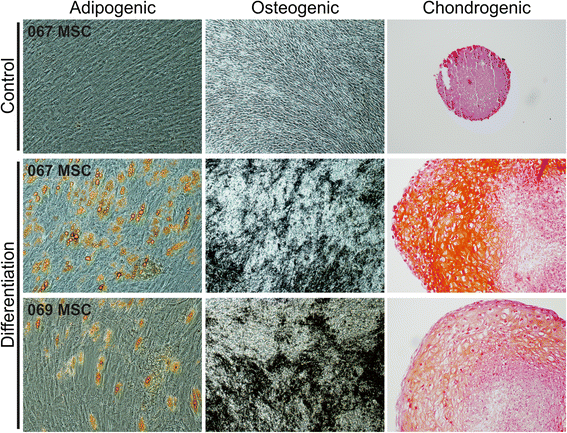
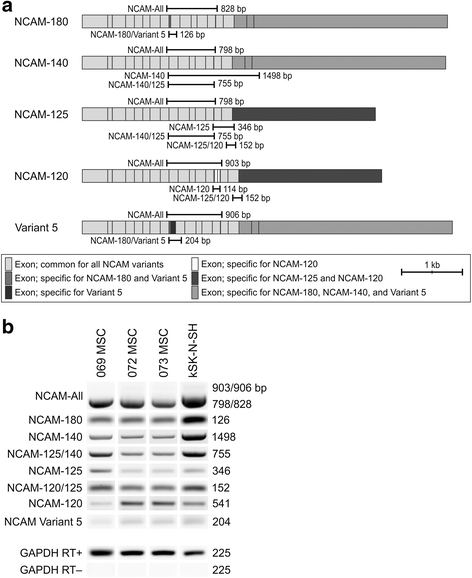
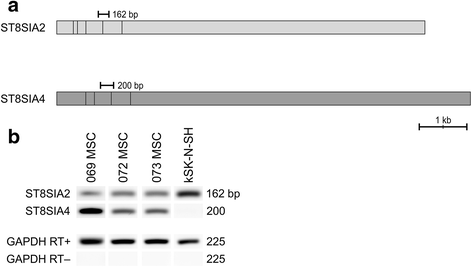
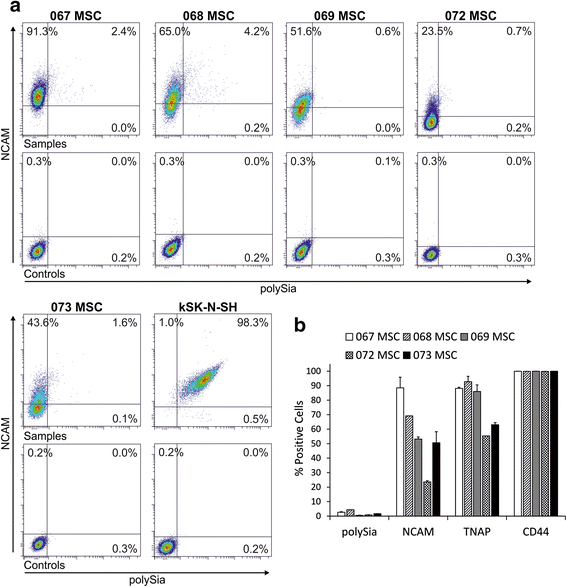


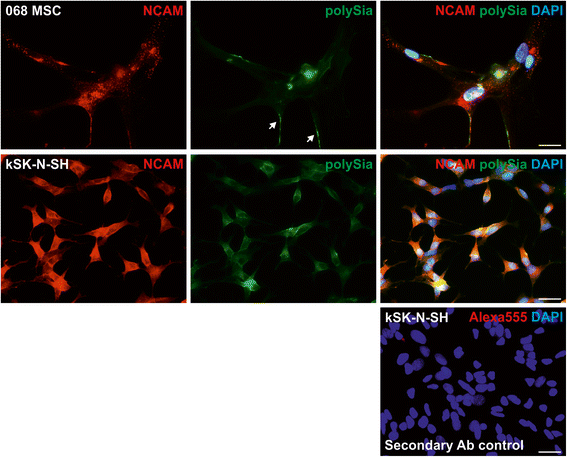
Similar articles
-
Molecular Interactions of the Polysialytransferase Domain (PSTD) in ST8Sia IV with CMP-Sialic Acid and Polysialic Acid Required for Polysialylation of the Neural Cell Adhesion Molecule Proteins: An NMR Study.Int J Mol Sci. 2020 Feb 26;21(5):1590. doi: 10.3390/ijms21051590. Int J Mol Sci. 2020. PMID: 32111064 Free PMC article.
-
Expression of the neural cell adhesion molecule and polysialic acid in human neuroblastoma cell lines.Int J Oncol. 2011 Aug;39(2):417-24. doi: 10.3892/ijo.2011.1038. Epub 2011 May 10. Int J Oncol. 2011. PMID: 21567084
-
Impact of the polysialyltransferases ST8SiaII and ST8SiaIV on polysialic acid synthesis during postnatal mouse brain development.J Biol Chem. 2008 Jan 18;283(3):1463-1471. doi: 10.1074/jbc.M708463200. Epub 2007 Nov 28. J Biol Chem. 2008. PMID: 18045870
-
A Possible Modulation Mechanism of Intramolecular and Intermolecular Interactions for NCAM Polysialylation and Cell Migration.Curr Top Med Chem. 2019;19(25):2271-2282. doi: 10.2174/1568026619666191018094805. Curr Top Med Chem. 2019. PMID: 31648641 Review.
-
3D structural conformation and functional domains of polysialyltransferase ST8Sia IV required for polysialylation of neural cell adhesion molecules.Protein Pept Lett. 2015;22(2):137-48. doi: 10.2174/0929866521666141019192221. Protein Pept Lett. 2015. PMID: 25329332 Review.
Cited by
-
Blood-based CNS regionally and neuronally enriched extracellular vesicles carrying pTau217 for Alzheimer's disease diagnosis and differential diagnosis.Acta Neuropathol Commun. 2024 Mar 5;12(1):38. doi: 10.1186/s40478-024-01727-w. Acta Neuropathol Commun. 2024. PMID: 38444036 Free PMC article.
-
Internalization of a polysialic acid-binding Escherichia coli bacteriophage into eukaryotic neuroblastoma cells.Nat Commun. 2017 Dec 4;8(1):1915. doi: 10.1038/s41467-017-02057-3. Nat Commun. 2017. PMID: 29203765 Free PMC article.
-
Unveiling heterogeneity in MSCs: exploring marker-based strategies for defining MSC subpopulations.J Transl Med. 2024 May 15;22(1):459. doi: 10.1186/s12967-024-05294-5. J Transl Med. 2024. PMID: 38750573 Free PMC article. Review.
-
Levetiracetam Protects Against Cognitive Impairment of Subthreshold Convulsant Discharge Model Rats by Activating Protein Kinase C (PKC)-Growth-Associated Protein 43 (GAP-43)-Calmodulin-Dependent Protein Kinase (CaMK) Signal Transduction Pathway.Med Sci Monit. 2019 Jun 22;25:4627-4638. doi: 10.12659/MSM.913542. Med Sci Monit. 2019. PMID: 31266934 Free PMC article.
-
Siglec-6 as a therapeutic target for cell migration and adhesion in chronic lymphocytic leukemia.Nat Commun. 2024 Jun 18;15(1):5180. doi: 10.1038/s41467-024-48678-3. Nat Commun. 2024. PMID: 38890323 Free PMC article.
References
MeSH terms
Substances
LinkOut - more resources
Full Text Sources
Other Literature Sources
Research Materials
Miscellaneous

